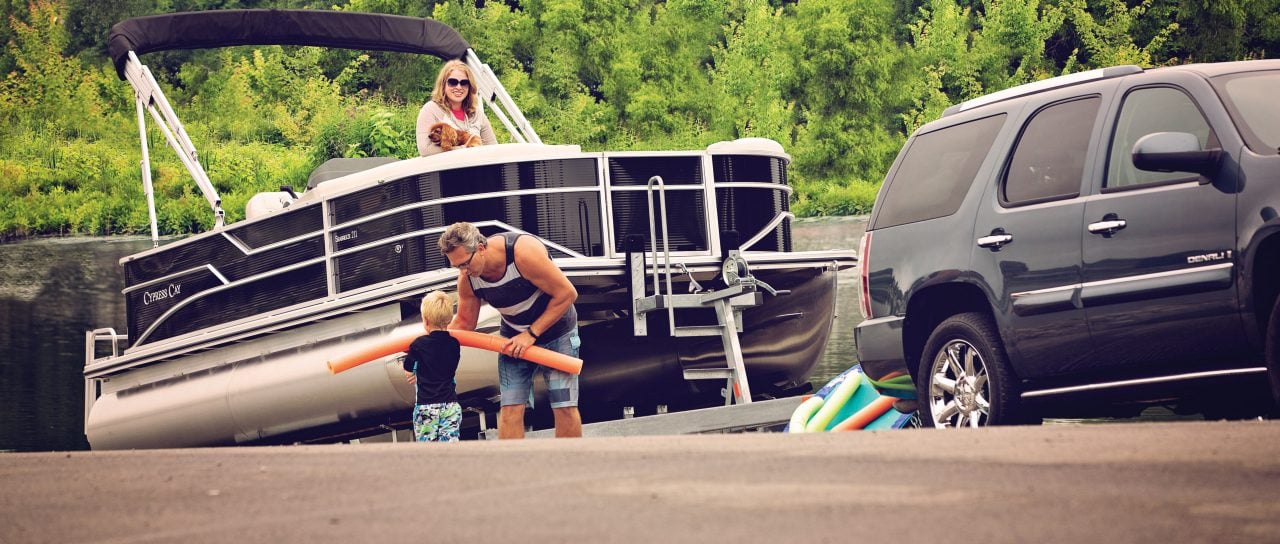TRAILERING AND LAUNCHING

How to Trailer and Launch Your Boat
As you plan to take your boat out on water, trailering and launching your boat can be quite a daunting task. If you have not had a lot of practice with this process, read our tips below on how to trailer, launch and retrieve your boat.
Trailering
A properly selected trailer supports the boat appropriately, makes towing safer and enables easy loading and unloading of the boat. Below are some of the guidelines to adhere to:
- Make sure that the hitch ball on the trailer is the exact same size as your vehicle’s coupler. Make sure the coupler’s trigger lock is securely latched.
- It is advisable to crisscross the safety chains under the trailer tongue before hooking them to the vehicle.
- Connect the trailer lights and make sure the running lights, brake lights and turn signals are operating properly.
- The winch cable should be attached to the bow eye and the bow eye safety chain should also be connected. Leave the winch mechanism engaged when the boat is in transport.
- When you are towing a trailer, be aware that the trailer’s weight will impact the power and braking abilities of your vehicle. The trailer requires a wider turning radius than the tow vehicle, so don’t cut corners too tightly.
Launching
Once you have reached the boat ramp, prior to launching your boat in the water, make sure that you handle the last-minute preparations, including:
- Load your boat with all of the safety equipment and gear for the day.
- Unhook all the tie-downs and safety cables except the bow strap.
- Put in the drain plug.
- Unplug the trailer lights.
- Put the boat key in the ignition (but do not start).
- Trim up the motor to avoid striking the prop (if not already trimmed up for transport).
- Attach lines to the bow and stern cleats.
- If you are launching the boat by yourself, you may need a bow line to steady the boat on release.
Now that you are ready to launch, get your vehicle and boat in line at the boat ramp and follow these steps:
- Slowly back the trailer down the ramp until the stern of the boat just begins to float.
- Shift the tow vehicle into Park and engage the parking brake.
- Move to the front of the trailer (be careful as the boat ramps are often slippery) and slowly release the bow strap until it can be unhooked. Keep a hand on the bow line.
- Pass the bow line to a friend on the dock and lightly push the boat off the trailer into the water.
- Secure your boat to the dock and move your vehicle away from the ramp.
- Have your friend walk the boat down the dock to free up space for the next boat to be launched.
Retrieving
Having enjoyed your day on the water, it is time to bring the boat back to the ramp and load it on the trailer. This process is very similar to the launch process, just in reverse.
- Tie your boat to the dock until your trailer is in the position at the ramp.
- Back the trailer down the ramp until the wheels are completely submerged under the water. As you are backing it into the water, remember to position it at the same depth that you use for launching.
- The boat operator brings in the boat slowly and lines up the boat in the center of the trailer and keeps just enough power on to slide completely on the trailer and contact the bow guard on the trailer.
- As you idle towards the trailer, it is important that you are pointing the bow at the center of the trailer. If you are not on center, back off and start over again.
- Once the boat is within a few inches or in direct contact with the winch post, attach the bow strap to the bow eye and winch it into place before pulling the trailer out of the water.
- Pull the vehicle slowly, but firmly up the ramp.
- Prepare your boat for transport by transferring gear back to the vehicle, hook up and check your lights and secure tie-downs.


